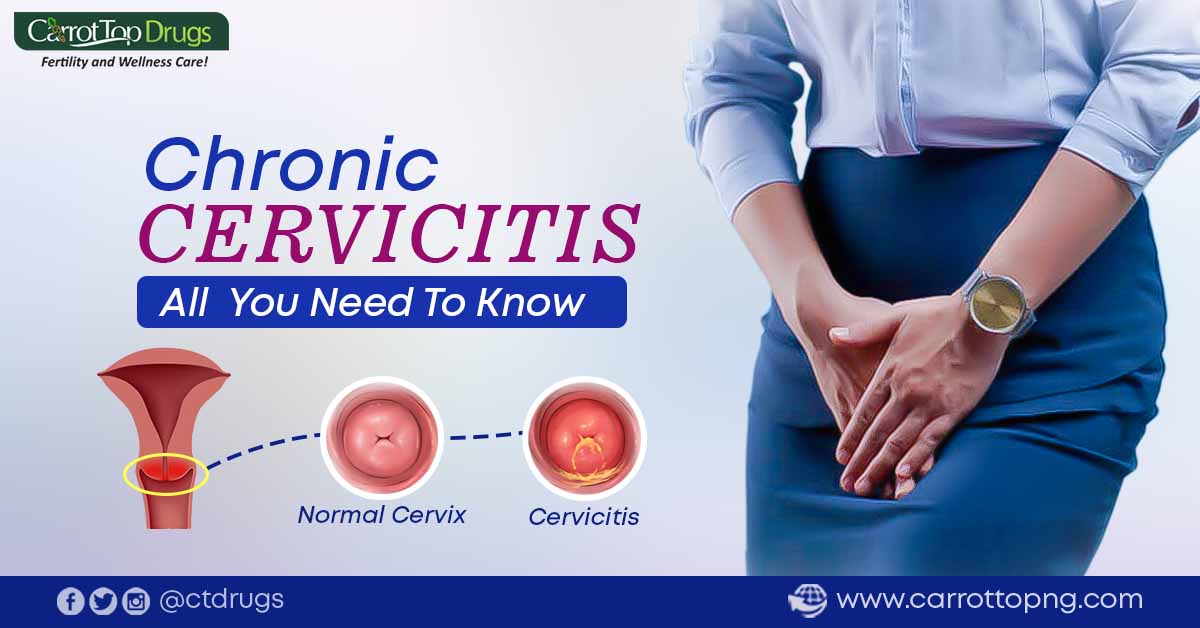Introduction
Chronic cervicitis is a medical condition that affects many women worldwide. It refers to the inflammation of the cervix. The cervix is the lower part of the uterus (womb) that connects to the vagina. This condition can cause discomfort and lead to various complications if left untreated. In this article, we will delve into the causes, symptoms, treatment options, preventive measures, and other important aspects of chronic cervicitis.
Understanding the Causes of Chronic Cervicitis
Chronic cervicitis can occur due to various factors. Infection is one of the primary causes. Infections such as bacterial vaginosis, yeast infections, and sexually transmitted infections like chlamydia, gonorrhea, and herpes simplex virus can contribute to the development of long-term cervicitis. In particular, certain strains of the human papillomavirus (HPV) have been strongly associated with this long-term cervicitis.
It’s important to note that chronic cervicitis can result from a persistent or recurring infection. When the cervix is repeatedly exposed to infectious agents, it can lead to long-term inflammation and the development of chronic cervicitis. Individuals with a history of multiple sexual partners, unprotected sex, or a weakened immune system are at a higher risk of developing chronic cervicitis.
Aside from infections, chronic cervicitis can also be triggered by non-infectious factors. Prolonged or repeated exposure to irritants, such as certain chemicals found in personal care products, douches, or tampons, can irritate the cervix and contribute to chronic inflammation.
In some cases, hormonal imbalances or changes in the cervical cells can also play a role in the development of long-term cervicitis. Fluctuations in hormone levels, such as those experienced during pregnancy or menopause, can affect the cervix’s susceptibility to inflammation and infection. Additionally, certain cervical conditions, such as cervical ectropion or cervical polyps, may increase the risk of long-term cervicitis.
It’s worth noting that while this long-term cervicitis can be caused by various factors, the precise cause may not always be identified. In such cases, it is referred to as non-specific chronic cervicitis. Proper evaluation and diagnosis by a healthcare professional are essential to determine the underlying cause and guide appropriate treatment.
Common Practices That Can Lead to Chronic Cervicitis
Chronic cervicitis can be influenced by certain common practices and behaviors. Being aware of these practices and making informed choices can help reduce the risk of developing long-lasting cervicitis. Let’s explore some of these factors:
1. Unprotected Sex: Engaging in unprotected sex, especially with multiple partners, increases the risk of contracting sexually transmitted infections (STIs) that can lead to chronic cervicitis.
2. Poor Hygiene Practices: Maintaining good personal hygiene is crucial for vaginal health. Excessive and harsh cleansing, especially with scented soaps or douches, can disrupt the natural balance of the vagina and irritate the cervix.
3. Chemical-Laden Personal Care Products: Some personal care products, such as certain soaps, bubble baths, and feminine hygiene sprays, contain chemicals that can cause irritation and inflammation of the cervix.
4. Sharing Personal Items: Sharing personal items like towels, underwear, or sex toys can facilitate the transmission of infections and increase the risk of chronic cervicitis.
5. Irritating Clothing Choices: Wearing tight-fitting clothes or synthetic materials that do not allow proper airflow can create a moist and warm environment, promoting the growth of bacteria and increasing the risk of chronic cervicitis.
6. Delayed Seeking of Medical Attention: Ignoring persistent symptoms such as abnormal vaginal discharge, pelvic pain, or discomfort during sexual intercourse can lead to a delay in diagnosis and appropriate treatment.
7. Smoking: Smoking weakens the immune system and reduces the body’s ability to fight infections. This can make individuals more susceptible to developing chronic cervicitis.
Signs and Symptoms of Chronic Cervicitis: Recognizing the Indicators
Chronic cervicitis can manifest through various signs and symptoms. Here are some common signs and symptoms associated with this condition:
1. Abnormal Vaginal Discharge: One of the hallmark symptoms of long-term cervicitis is the presence of abnormal vaginal discharge. The discharge may appear yellowish, greenish, or grayish and may have a foul odor. The consistency can range from thin and watery to thick and sticky.
2. Vaginal Bleeding: Women with chronic cervicitis may experience abnormal vaginal bleeding, which can manifest as spotting between periods or after sexual intercourse. The inflammation of the cervix can cause tiny blood vessels to rupture, leading to slight bleeding.
3. Pelvic Pain or Discomfort: Chronic cervicitis can cause pelvic pain or discomfort, although it may vary in intensity from person to person. The pain can be dull or cramp-like and may be present constantly or worsen during sexual intercourse.
4. Painful Intercourse: Chronic cervicitis can lead to dyspareunia, or pain during sexual intercourse. The inflamed cervix can be sensitive to touch, causing discomfort or pain during penetration.
5. Urinary Symptoms: In some cases, chronic cervicitis can cause urinary symptoms such as increased frequency of urination or a burning sensation during urination.
6. Visible Changes to the Cervix: In certain instances, a healthcare professional may identify visible changes to the cervix during a pelvic examination. These changes can include redness, swelling, or the presence of tiny blood vessels on the surface of the cervix.
Diagnosing Chronic Cervicitis: Steps to Identify the Condition
Diagnosing chronic cervicitis involves a comprehensive evaluation by a healthcare professional. Here are the steps typically involved in the diagnostic process:
1. Medical History Assessment: The healthcare professional will begin by taking a detailed medical history, including information about the patient’s symptoms, menstrual cycle, sexual activity, contraceptive methods, and any previous infections or treatments.
2. Pelvic Examination: A thorough pelvic examination is a key component of diagnosing chronic cervicitis. During the examination, the healthcare provider visually inspects the external genitalia, cervix, and vagina for any signs of inflammation or abnormalities.
3. Pap Smear: A Pap smear, also known as a cervical cytology test, is commonly performed during a pelvic examination. It involves the collection of cells from the cervix using a small brush or spatula. These cells are then sent to a laboratory for analysis.
4. Additional Tests: Depending on the suspected underlying cause of chronic cervicitis, the healthcare provider may recommend additional diagnostic tests. These tests can include:
a. Microbiological Testing: To identify the presence of bacterial, viral, or fungal infections, swabs may be taken from the cervix to collect samples for laboratory testing.
b. Sexually Transmitted Infection (STI) Screening: Since certain sexually transmitted infections, such as chlamydia, gonorrhea, and herpes, can cause chronic cervicitis, the healthcare provider may recommend STI screening.
5. Biopsy: In some cases, if the healthcare provider suspects a more serious underlying condition, such as cervical dysplasia or cervical cancer, a biopsy may be recommended. During a biopsy, a small sample of cervical tissue is taken and sent to a laboratory for examination under a microscope. This helps determine if there are any abnormal or precancerous cells present.
Treating Chronic Cervicitis: Effective Strategies for Relief
When it comes to treating chronic cervicitis, targeted interventions can help alleviate symptoms and promote healing. The treatment approach may vary depending on the underlying cause of long-term cervicitis. Let’s explore some effective strategies for managing this condition:
1. Identifying the Underlying Cause
Proper diagnosis is crucial in determining the most appropriate treatment for chronic cervicitis. A healthcare professional will conduct a thorough evaluation, which may include a pelvic examination, Pap smear, and testing for sexually transmitted infections. Identifying and treating any underlying infections, such as bacterial vaginosis, yeast infections, or sexually transmitted infections, is essential for effective management of chronic cervicitis.
2. Antibiotic Therapy
If chronic cervicitis is caused by a bacterial infection, antibiotic therapy may be prescribed. The specific antibiotic will depend on the identified bacteria and may be administered orally, topically, or both.
3. Antiviral Medications
In cases where chronic cervicitis is associated with viral infections, such as herpes simplex virus or certain strains of human papillomavirus (HPV), antiviral medications may be prescribed. These medications can help manage symptoms, reduce viral replication, and promote healing of the cervix.
4. Topical Treatments
In some instances, healthcare providers may recommend the use of topical treatments to alleviate symptoms and reduce inflammation in chronic cervicitis. These treatments may include medicated creams, gels, or suppositories that contain anti-inflammatory or healing agents. One of the supplements that we recommend is our EVERGREEN CM which helps to make the cervix healthy. It also helps to improve the chances of getting pregnant.
5. Hormonal Therapy
Hormonal imbalances or fluctuations can contribute to chronic cervicitis. In cases where hormonal factors are involved, hormonal therapy may be recommended. This may include hormonal creams, patches, or oral medications to help regulate hormone levels and restore the natural balance of the cervix.
6. Lifestyle Modifications
Certain lifestyle modifications can complement medical treatment and support healing. This may include practicing safe sex, maintaining good hygiene, avoiding irritants such as harsh soaps or douches, and adopting a healthy lifestyle.
7. Regular Follow-Up and Monitoring
After initiating treatment for chronic cervicitis, regular follow-up visits with a healthcare professional are crucial. These visits allow for monitoring of treatment effectiveness, evaluation of symptoms, and adjustment of the treatment plan if necessary.
Preventing Chronic Cervicitis
Prevention is key when it comes to chronic cervicitis. By adopting proactive measures, individuals can significantly reduce the risk of developing long-term cervicitis and maintain optimal vaginal health. Let’s explore some effective strategies for prevention:
1. Practise Safe Sex
Engaging in safe sexual practices is crucial for preventing chronic cervicitis. Consistently using barrier methods, such as condoms, during sexual activity can provide protection against sexually transmitted infections (STIs) that can lead to long-term cervicitis. It is essential to communicate openly with sexual partners, get tested regularly for STIs, and consider vaccination against high-risk HPV strains.
2. Maintaining Good Personal Hygiene to Prevent Chronic Cervicitis
By adopting healthy habits and avoiding certain practices, individuals can reduce the risk of developing chronic cervicitis. Let’s delve deeper into the importance of good personal hygiene and explore preventive measures:
a. Gentle Cleansing
Maintaining cleanliness in the genital area is important, but it is equally important to avoid excessive and harsh cleansing. Overwashing can strip the vagina of its natural lubrication and disrupt the delicate balance of beneficial bacteria. This disruption leads to irritation and inflammation of the cervix. Instead, opt for gentle cleansing using warm water and a mild, pH-balanced cleanser specifically formulated for intimate use.
b. Avoid Douching:
Douching is a common practice that involves rinsing the vagina with water or other solutions. It can disrupt the natural pH balance of the vagina, wash away protective bacteria, and increase the risk of infections, including chronic cervicitis. It is best to avoid douching altogether.
c. Say No to Scented Soaps and Products
Many scented soaps, bubble baths, and feminine hygiene products contain harsh chemicals and fragrances that can irritate the delicate tissues of the vagina and cervix. Opt for unscented, hypoallergenic products that are specifically designed for intimate hygiene.
d. Proper Wiping Technique
Always wipe from front to back after urination or bowel movements. This helps prevent the spread of bacteria from the anal area to the vagina, reducing the risk of infections that can contribute to chronic cervicitis.
e. Use Clean and Breathable Underwear
Wearing clean, breathable cotton underwear helps maintain a healthy vaginal environment. Cotton allows proper airflow and absorbs moisture, reducing the risk of bacterial overgrowth and irritation. Avoid tight-fitting underwear or those made from synthetic materials that can trap moisture and create an environment conducive to bacterial growth.
f. Change Menstrual Products Regularly
If you use tampons or menstrual pads during your period, it is important to change them regularly to prevent the build-up of bacteria and potential infections.
g. After-Sex Care
After sexual intercourse, it is advisable to urinate and gently cleanse the genital area to flush out any bacteria that may have entered the urethra or vagina.
3. Choose Gentle, Chemical-Free Products:
Opting for gentle, chemical-free personal care products can help prevent irritation and inflammation of the cervix. Choose products that are specifically formulated for sensitive skin and labeled as pH-balanced.
4. Get Regular Check-Ups and Screenings
Regular check-ups and screenings are essential for early detection and prevention of chronic cervicitis.
5. Practise Healthy Lifestyle Habits
It is important to maintain a balanced diet rich in nutrients, engage in regular physical activity, manage stress levels effectively, and get sufficient sleep. These lifestyle factors help support a strong immune system, which plays a crucial role in preventing infections and inflammation.
6. Avoid Smoking and Secondhand Smoke
Quitting smoking or avoiding exposure to secondhand smoke can significantly reduce the risk and promote a healthier cervical environment.
7. Educate Yourself and Seek Medical Advice
Staying informed about sexual health, reproductive hygiene, and common risk factors for chronic cervicitis is essential. Regularly consult with healthcare professionals for guidance, especially if you experience persistent symptoms or have concerns about your cervical health.
Frequently Asked Questions (FAQs)
Q. Is chronic cervicitis a sexually transmitted infection (STI)?
A. Yes, it can be caused by sexually transmitted infections, but it is not classified as an STI itself. It is an inflammatory condition that can be triggered by various factors.
Q. Can chronic cervicitis be prevented?
A. Practicing safe sex, getting vaccinated against HPV, and maintaining good hygiene can help reduce the risk of chronic cervicitis.
Q. Can chronic cervicitis affect pregnancy?
A. Yes, it can potentially impact fertility and increase the risk of complications during pregnancy. Seeking appropriate medical care and guidance is crucial for individuals planning to conceive or are already pregnant.
Q. Are there any natural remedies for chronic cervicitis?
A. While natural remedies can provide some relief, they should not replace medical treatment. Sitz baths and maintaining good hygiene can complement medical interventions.
Q. When should I seek medical attention for chronic cervicitis?
A. If you experience persistent symptoms such as abnormal discharge, pelvic pain, or discomfort during intercourse, it is essential to consult a healthcare provider for evaluation and appropriate treatment.
Conclusion
Chronic cervicitis is a condition that affects many women and can cause discomfort and complications if left untreated. Understanding the causes, symptoms, and treatment options is crucial for managing this condition effectively. By adopting preventive measures, seeking timely medical care, and maintaining a healthy lifestyle, individuals can reduce the risk and impact of chronic cervicitis. Regular screenings and follow-up appointments are essential for early detection and intervention. Remember to consult with a healthcare professional for personalized guidance and treatment.

















